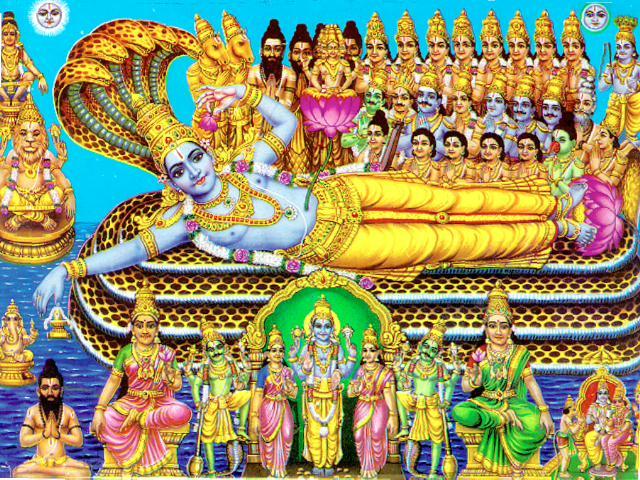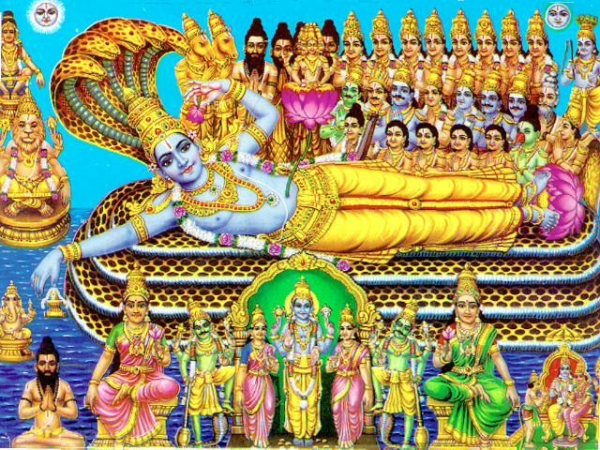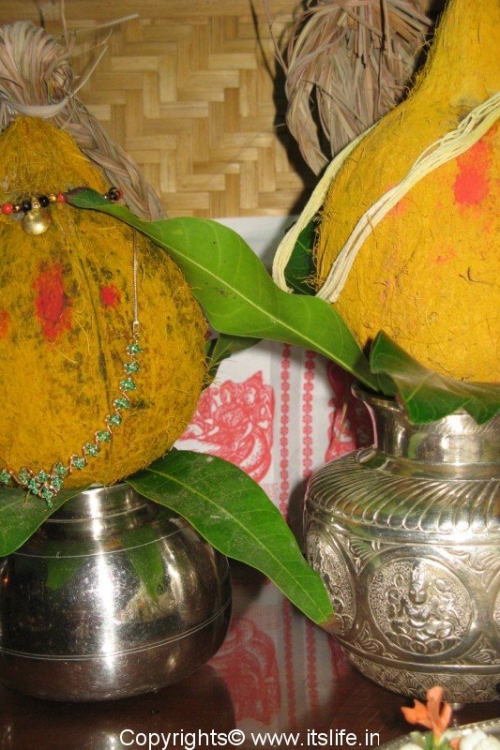“Kaayena Vaachaa Manasendriyairvaa
Buddhyaatmanaa Vaa Prakriteh Svabhaavaatah
Karomi Yadhyadh Sakalam Parasmai
Naaraayanaayeti Samarpayaami”
The meaning of the above shloka is: “I offer everything to Lord Vishnu (Narayana); my actions, my soul, good and bad. I bow to you great lord, Vishnu”.
Ananthapadmanabha Swamy Vratha / religious observance is also known as Anthanachaturdashi. Ananthapadmanabha is none other than Lord Vishnu the creator, one who has neither birth nor death. The festival falls on Chathurdashi (14th day) in the Hindu month of Bhadrapada, August – September in Gregorian calendar. For the festival date click here.
Lord Vishnu is worshipped in his “Seshashayana“(god sleeping on a snake) posture. Anatha” means “infinite / endless” and it is believed that by following this vratha, one is bestowed with Ayushya / life, Arogya / health and Gyana / enlightenment. This vratha is mentioned in the Bhavishyothara Purana, where Lord Krishna suggests Yudhishtira (eldest brother of Pandavas in the epic Mahabharatha) to perform this during their 14 years of exile.
Clean the place of worship and draw Ananthanagantu rangoli, keep two Kalashas one for Vishnu and the other for Lakshmi. Keep Ananthana Vastra behind the Kalasha. Make 2 – adishesha / snake with 7 hedae / heads using darbe / sacred grass. Place one on each of the Kalasha. For one kalasha put a single Janivara / Yagnopaveetha / sacred thread. For the other decorate with jewellery and mangalya. Keep Ananthana Dhara / 14 lined red thread on betel leaves and nut near the Kalasha.
Keep some yellow manthrakshathe on the side for Yamuna pooja as Sri Krishna’s favorite river is Yamuna.
Start by doing pooja to Ganapathy and river Yamuna. Install the Kalasha and welcome god into it. Perform the pooja with 14 lined Gejjevastra, flowers, leaves and red Manthrakshathe. Chant Vishnusahasranama. Offer fruits, festive food like Kayi Holige, Gasagase Payasa, Chitranna, Palya, Kosambari and 28 Kajjaya / sweet dish as naivedya / blessed food. Chant Vishnu Sahasranama. Perform pooja to the thread also. Do Aarathi. After the pooja tie the sacred red thread on right hand for men and on left hand for women. Give away 14 Kajjaya to a Brahmin as vayana dana / donation. Invite couples over for lunch. Give “Vayana dana” to the priest and do namaskara / bow to him. Vayana Dana means Coconut, Fruit, Rice, Money, Betel leaves and nuts.
This vratha / custom is performed for 14 years and on the 14th year perform udyapane / ritual to stop the custom.
The number 14 is very auspicious in this festival because the 14 worlds are present in Lord Vishnu’s lap and the meaning of Padmanabha means that the lotus has bloomed from his tummy and from the lotus is born Lord Brahma, who is the creator of life on earth hence, for everything the beginning is Lord Ananthapadmanabha.
For festival food recipes click here.
For festival snacks and drinks recipes click here.




